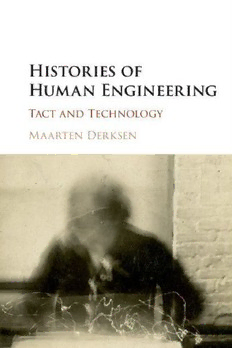
Histories of Human Engineering: Tact and Technology PDF
Preview Histories of Human Engineering: Tact and Technology
Histories of Human Engineering Thedreamofcontroloverhumanbehaviourisanolddream,sharedby manycultures.Thisfascinatingaccountofthehistoriesofhumanengi- neeringdescribeshowtechnologiesofmanagingindividualsandgroups weredevelopedfromthenineteenthcenturytothepresentday,ranging frombrainwashingandmindcontroltoDaleCarnegie’sartofdealing withpeople.Derksenrevealsthatcommontoallofthemistheperpetual tensionbetweenthedesiretocontrolpeople’sbehaviourandtheresis- tancethisprovokes.Thus,toinfluenceotherpeoplesuccessfully,tech- nology had to be combined with tact: with a personal touch, with a subtlehintorwithoutrightdeception,manipulationsweremadepala- table or invisible. Combining psychological history and theory with insightsfromscienceandtechnologystudiesandrhetoricalscholarship, Derksenoffersafreshperspectiveonhumanengineeringthatwillappeal to those interested in the history of psychology and the history of technology. Maarten Derksen is Assistant Professor in the Faculty of Behavioural and Social Sciences at the University of Groningen. He has authored Iedereendoetaan psychologie(1999)and,withSybeTerwee, translated Wittgenstein’s Philosophical Investigations into Dutch (1992; 2nd ed. 2006).HewasanhonoraryfellowoftheScienceStudiesCentreofthe University of Bath, an associate of the ‘What Makes Organization?’ research programme at the Copenhagen Business School, and is cur- rentlyamemberoftheeditorialboardofTheory&Psychology. Histories of Human Engineering Tact and Technology Maarten Derksen UniversityofGroningen UniversityPrintingHouse,CambridgeCB28BS,UnitedKingdom OneLibertyPlaza,20thFloor,NewYork,NY10006,USA 477WilliamstownRoad,PortMelbourne,VIC3207,Australia 4843/24,2ndFloor,AnsariRoad,Daryaganj,Delhi–110002,India 79AnsonRoad,#06–04/06,Singapore079906 CambridgeUniversityPressispartoftheUniversityofCambridge. ItfurtherstheUniversity’smissionbydisseminatingknowledgeinthepursuitof education,learning,andresearchatthehighestinternationallevelsofexcellence. www.cambridge.org Informationonthistitle:www.cambridge.org/9781107057432 DOI:10.1017/9781107414921 ©MaartenDerksen2017 Thispublicationisincopyright.Subjecttostatutoryexception andtotheprovisionsofrelevantcollectivelicensingagreements, noreproductionofanypartmaytakeplacewithoutthewritten permissionofCambridgeUniversityPress. Firstpublished2017 PrintedintheUnitedKingdombyClays,StIvesplc AcataloguerecordforthispublicationisavailablefromtheBritishLibrary. ISBN978-1-107-05743-2Hardback CambridgeUniversityPresshasnoresponsibilityforthepersistenceoraccuracyof URLsforexternalorthird-partyinternetwebsitesreferredtointhispublication anddoesnotguaranteethatanycontentonsuchwebsitesis,orwillremain, accurateorappropriate. Contents Acknowledgements pagevi 1 Introduction 1 2 TactandTechnology 13 3 ScientificManagementandtheHumanFactor 33 4 ‘SocialTechnology’ 56 5 DaleCarnegieandtheFineArtofDealingwithPeople 78 6 KarlPopper’sSocialTechnologyandthePersonal Element 104 7 TactfulLeadership 114 8 MindControl 139 9 ThePrimingSaga:TheSubtleTechnologyof PsychologicalExperimentation 177 10 Conclusion 199 Notes 209 Bibliography 245 Index 267 v Acknowledgements Chapter3isarevisedversionof‘TurningMenintoMachines?Scientific Management,IndustrialPsychology,andthe“HumanFactor”’(Derksen, Maarten;JournaloftheHistoryoftheBehavioralSciences50,no.2(2014): 148–65).IthankSigneVikkelsøforherdetailedandconstructivereview; reviewer2foratleasttakingthetimetoreadthemanuscriptandsayinga fewwords;theeditor,IanNicholson,forguidingthemanuscripttopub- lication;andthepublisher,JohnWileyandSons,forgivingpermissionto usethearticlehere. Chapter4isarevisionof‘TheHistoryof“SocialTechnology”,1898– 1930’(Derksen,MaartenandWierenga,Tjardie;HistoryandTechnology 29,no.4(2013):311–30),whichcanbefoundatwww.tandfonline.com. I thank the editor, Martin Collins, for his expert handling of the manu- script;thetworeviewersfortheirhelpfulreviews;thepublisher,Taylor& Francis,forgivingpermissiontousethearticlehere;andaboveallTjardie Wierenga for working on it with me and allowing me to use it for this book. The project of which this book is a product has its origin in a dinner conversation years ago, when Anne Beaulieu and I discovered we were bothinterestedinsocialtechnology.Assoofteninourlifetogether,Anne turned what would otherwise have remained merely an interesting idea intoaprojectwecouldworkontogether.Mygreatestdebtistoher. Without Hetty Marx, formerly commissioning editor at Cambridge UniversityPress,therewouldhavebeennobook.I’mstilldeeplyembar- rassed that she had to remind me twice that I had promised to write a proposal. I hope the final product lives up to the faith she had in me. I thankthereviewersfortheircommentsontheproposalandthefirstdraft. When Hetty left to become an independent editor Janka Romero took over,andshehasbeenagreathelp. I’mverygratefultoLizBartonRoyerandthestaffoftheDrs.Nicholas and Dorothy Cummings Center for the History of Psychology at the University of Akron, Ohio, for their assistance during my visit there. At myownfacultylibrarySanderSprikwasinvaluable. vi Acknowledgements vii Overtheyears,Ihavebenefittedfromconversationswithmanycollea- gues.AnneBeaulieu,SigneVikkelsøandIorganisedaworkshopin2009 on social technology, generously funded by WTMC, the Netherlands Graduate Research School of Science, Technology and Modern Culture.OurdiscussionswithKatjaMayer,TerezaStöckelová,Kathrin Braun, Javier Lezaun, Ingmar Lippert, Jonna Brenninkmeijer, Katia Dupret Søndergaard, Julie Sommerlund, Sara Malou Strandvad, Paul WoutersandBasvanHeurwereagreatjoyandinspiration.Katjapointed me to Charles Henderson and his social technology and thus made me realisethattheconcepthasahistory.SteveBrowncouldn’tmakeit,but hisworkisalwaysimportanttome. PaulduGayandSigneVikkelsøwerekindenoughtohavemeoverfora fewdaysin2011attheDepartmentofOrganizationoftheCopenhagen Business School, where I had inspiring discussions about organisation andmanagementwiththemandwithKarenBoll,ChrisGreyandChris Mathieu and, at the Department of Management, Politics and Philosophy,withKasparVilladsen. Ihavethegoodfortunetoworkintheworld’sbestTheoryandHistory ofPsychologygroup.Overtheyearsmyideasanddraftswerelistenedto, read and commented on by Jonna Brenninkmeijer, Adeena Mey, Hilde Tjeerdema, Jess Cadwallader, Felix Schirmann, Trudy Dehue, Carlos Baum, Stephan Schleim, Berend Verhoeff and Douwe Draaisma. One wayoranother,theywereallimportanttome,andIlovethemall,butmy greatest debt is to Douwe, who read my original proposal and all the chaptersandofferedinvaluablesuggestions.Ifthisbookcomesanywhere near the clarity and insight of his work, readers may count themselves lucky. Dennis Bryson prompted me to clarify why I think the difference between ‘social technology’ and ‘social engineering’ is significant. My ideas about replication were much influenced by my collaboration with EricRietzschelandbyanextensiveemailconversationwithHansRadder. NathanielRiverstaughtmealotaboutrhetoric,kairosinparticular.My friendSteveCourse,somewhatworryingly,turnedouttobeanexperton the CIA; he read the chapter about brainwashing and offered many valuable suggestions. (He is convinced Dulles was in on the secret, by the way.) Marcia Holmes read the chapter too and sent me extensive, helpfulcomments. I am immensely grateful to all these people. No doubt many of them willbesurprisedbywhat,ifanything,cameoftheiradvice.Perhapsothers will, upon finishing this book, wish I had consulted them too, thinking thatmighthavedonesomegood.Ineithercase,Iacceptfullresponsibility forallofthebook’sflaws. 1 Introduction ARevolutioninMarketing A revolution has been proclaimed in the field of marketing: the age of neuromarketingisdawning.Nowthatresearcherscanlookdirectlyinto thebrainwithanfMRIscanner,theycanseewhatreallyattractspeoplein anadvertisementortelevisioncommercialandwhatmovesthemtobuy a product. Neuromarketing research has found our ‘buy button’, and if youhavesomethingtosell,itcantellyouexactlyhowtopushthatbutton. Howitworksisdescribedinabookaimedatbusinessowners,salespeople and marketers titled The Buy Button.1 It was written by Martin de Munnik, one of the people behind Neurensics, an Amsterdam research and consulting firm that specialises in neuromarketing. In The Buy Button, subtitled The Secret of the Consumer’s Brain, De Munnik tells us ofthegroundbreakingdiscoverythatthedecisiontobuyaproductisthe resultoftheinterplaybetweenthreebrainareas:thenucleusaccumbens, theinsulaandthemedialprefrontalcortex.Thesethreeareastogetherare thebuybutton,‘thegreatestneuromarketingrevelationofalltime’,asthe book’scoverproclaims.CompanieslikeNeurensicshavetakenthisscien- tific discovery and turned it into practical applications. With an fMRI scanner they can look into the brain and see the activity in these areas whensubjectsarepresentedwith,forexample,differentadvertisements forbreakfastcerealornailpolish.Choosingthebestadvertisement,once an art based on gut feelings, has become a science. Marketing has been transformedintoa‘lotterywithoutblanks’.2That,atleast,istheclaim. Letusforthemomentputasidethequestionofwhethertherereallyis a buy button in the brain – suffice it to say that there are other neuro- marketing researchers who call the idea ‘bullshit’ and warn of ‘neuro- cowboys’harmingthefieldbyoversellingit.3Iwanttofocusonthedream thatthebuybuttonstandsfor:thedreamofknowingwhatreallymoves people and using that knowledge to manipulate their behaviour in an effectiveandefficientmanner.Themetaphorofabuttoninthebrainthat triggers an urge to buy a product represents an ideal of control over 1
